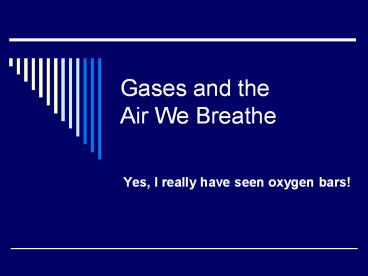Gases and the Air We Breathe - PowerPoint PPT Presentation
1 / 20
Title:
Gases and the Air We Breathe
Description:
The olfactory nerve at the top of our nasal cavity has receptors to bind to gas ... If properties move in the same direction when one of them is changed they are ... – PowerPoint PPT presentation
Number of Views:178
Avg rating:3.0/5.0
Title: Gases and the Air We Breathe
1
Gases and the Air We Breathe
- Yes, I really have seen oxygen bars!
2
What is a gas?
- A gas is a substance in which
- The molecules are widely spaced
- Diffuse rapidly
- Molecules can move freely and rapidly through out
the entire volume of their container - Are evenly dispersed throughout the entire
container - Highly compressible
3
What is in air?
- Mostly nitrogen
- 80
- Some oxygen
- 20
- Traces of other gases
- Argon 1
- Carbon dioxide .03
- Wow! Isnt that a small amount to cause sooo much
climate change
4
What is an ideal gas?
- A gas that obeys all of the gas laws at all
times. - Non-ideal gases do things like sink to the floor
or are beginning to transition into liquids
5
How do we smell?
- The olfactory nerve at the top of our nasal
cavity has receptors to bind to gas molecules in
the air. - We can smell 2000-5000 different compounds
- Our nerves are as sensitive as a blood hounds,
just not as plentiful and the olfactory center of
our brain is not as developed
6
Gaseous Systems
- Open Systems
- Allow gas to leave and not necessarily come back
- Closed systems
- Contain gas within a defined space
- All the better to study the nature of gasses
- Gas laws are based upon closed systems
7
Pressure/Volume Relationships
- Given a set volume that will not vary, if you put
more gas in it the pressure will increase - Ex Helium gas in a canister
- Given a set volume that will not vary, if you
take gas out of it the pressure will decrease - Ex As helium is used from the container the
pressure falls
8
Pressure/Volume Relationships
- Given a volume that will vary, if you put more
gas in it the volume will increase - Ex Helium pumped into a balloon
- Given a volume that will vary, if you allow gas
out, the volume will decrease - Ex Letting the helium out of the balloon lets
the balloon deflate
9
Pressure/Volume Relationships
- The relationship between pressure and volume is
predictable - Boyles Law
- P1V1 P2V2
- If you know any three of the above, you can
calculate the fourth - At sea level the pressure of gas is 1atmostphere
or 760 mmHg - 1 Pascal is 8 umHg
10
How is pressure related to volume?
- Think again about P1V1 P2V2
- If pressure goes up then volume must go down for
the equation to still be true - Therefore
- Pressure and volume are inversely related
11
How is temperature related to pressure?
- If temperature goes up pressure goes up
- Ex Heat a soda can and open it
- If temperature goes down pressure goes down
- Ex Put a soda can in the freezer for a while and
then open it - If properties move in the same direction when one
of them is changed they are said to be directly
proportional
12
What would pressure/temperature equations look
like?
- Charles Law
- P1 P2
- T1 T2
13
What if we look at temperature and pressure and
volume?
- If temperature goes up and pressure stays the
same - Volume had to go up
- If temperature goes up and volume stays the same
- Pressure had to go up
- All three of these are linked and if one varies,
the others will also
14
Whats the difference between force and pressure?
- Force is the amount of pressure over a given area
- Ex. Lbs/ft2
15
What will a pressure/volume/temperature equation
look like?
- P1V1 P2V2
- T1 T2
16
What is STP?
- Standard Temperature and Pressure
- Standard Temperature
- 273oK
- Standard Pressure
- 1 atmosphere
- At STP a mole of any ideal gas will take up 22.4L
17
What if we add more stuff?
- What if we add more moles of a substance to a
closed system - What will happen to pressure?
- What will happen to volume?
- What will happen to temperature?
- What will this look like in math?
18
Ideal Gas Law
- PV nRT
- What the heck is R?
- If you take one mole of a gas at STP
- R will always come out the same!
- It is the ideal gas constant
- 0.082 L atm
- moles K
19
Importance of Ozone
- Very little of it where we need it
- Blocks UV light from the sun
- UV light kills living tissues
- Used to sterilize
- Chlorofluorocarbons
- Break down and release Cl
- React with O3 and break it down to O2
20
Global Warming and Greenhouse Gases
- A greenhouse gas holds energy in the earths
atmosphere and prevents cooling - Greenhouse gases include
- CO2
- H2O
- Fluorocarbons
- Sulfur hexafluoride
- Nitrous oxide
- Methane































